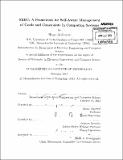| dc.contributor.advisor | Anant Agarwal and Srinivas Devadas. | en_US |
| dc.contributor.author | Hoffmann, Henry, 1977- | en_US |
| dc.contributor.other | Massachusetts Institute of Technology. Department of Electrical Engineering and Computer Science. | en_US |
| dc.date.accessioned | 2013-07-10T14:49:46Z | |
| dc.date.available | 2013-07-10T14:49:46Z | |
| dc.date.copyright | 2013 | en_US |
| dc.date.issued | 2013 | en_US |
| dc.identifier.uri | http://hdl.handle.net/1721.1/79500 | |
| dc.description | Thesis (Ph. D.)--Massachusetts Institute of Technology, Dept. of Electrical Engineering and Computer Science, 2013. | en_US |
| dc.description | Cataloged from PDF version of thesis. | en_US |
| dc.description | Includes bibliographical references (p. 165-172). | en_US |
| dc.description.abstract | Modern computing systems require applications to balance competing goals, e.g.,high performance and low power or high performance and high precision. Achieving the right balance for a particular application and system places an unrealistic burden on application programmers who must understand the power, performance, and precision implications of a variety of application and system configurations (e.g.,changing algorithms or allocating cores). To address this problem, we propose the Self-aware Computing framework, or SEEC. SEEC automatically and dynamically configures systems and applications to meet goals accurately and efficiently. While other self-aware implementations have been proposed, SEEC is uniquely distinguished by its decoupled approach, which allows application and systems programmers to separately specify goals and configurations, each according to their expertise. SEEC's runtime decision engine observes and configures the system automatically, reducing programmer burden. This general and extensible decision engine employs both control theory and machine learning to reason about previously unseen applications and system configurations while automatically adapting to changes in both application and system behavior. This thesis describes the SEEC framework and evaluates it in several case studies. SEEC is evaluated by implementing its interfaces and runtime system on multiple, modern Linux x86 servers. Applications are then instrumented to emit goals and progress, while system services are instrumented to describe available adaptations. The SEEC runtime decision engine is then evaluated for its ability to meet goals accurately and efficiently. For example, SEEC is shown to meet performance goals with less than 3% average error while bringing average power consumption within 92% of optimal. SEEC is also shown to meet power goals with less than 2% average error while achieving over 96% of optimal performance on average. Additional studies show SEEC reacting to maintain performance in response to unexpected events including fluctuations in application workload and reduction in available resources. These studies demonstrate that SEEC can have a positive impact on real systems by understanding high level goals and adapting to meet those goals online. | en_US |
| dc.description.statementofresponsibility | by Henry Hoffmann. | en_US |
| dc.format.extent | 172 p. | en_US |
| dc.language.iso | eng | en_US |
| dc.publisher | Massachusetts Institute of Technology | en_US |
| dc.rights | M.I.T. theses are protected by
copyright. They may be viewed from this source for any purpose, but
reproduction or distribution in any format is prohibited without written
permission. See provided URL for inquiries about permission. | en_US |
| dc.rights.uri | http://dspace.mit.edu/handle/1721.1/7582 | en_US |
| dc.subject | Electrical Engineering and Computer Science. | en_US |
| dc.title | SEEC : a framework for self-aware management of goals and constraints in computing systems | en_US |
| dc.title.alternative | Framework for self-aware management of goals and constraints in computing systems | en_US |
| dc.type | Thesis | en_US |
| dc.description.degree | Ph.D. | en_US |
| dc.contributor.department | Massachusetts Institute of Technology. Department of Electrical Engineering and Computer Science | |
| dc.identifier.oclc | 849652920 | en_US |
